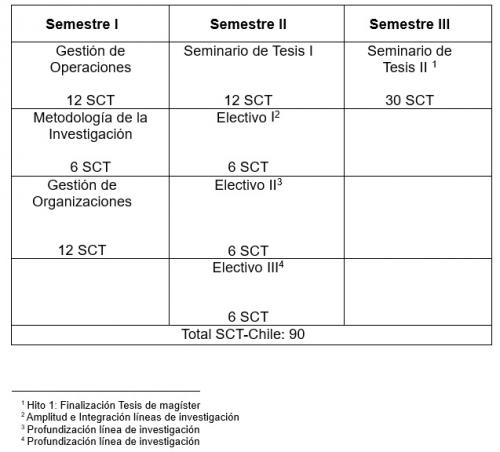You are here
Curricular Structure
The Program Study Plan includes a total of 8 subjects, corresponding to 90 SCT credits and 70 TEL credits (Exempt N°460 of January 17, 2024), distributed over 3 semesters, which will have a theoretical-epistemological emphasis. , methodological, breadth and depth. The theoretical-epistemological emphasis considers the subjects “Organization Management” and “Operations Management”. The methodological emphasis will be reflected in “Research Methodology”, “Thesis Seminar I” and “Thesis Seminar II”. Finally, the emphasis on breadth will be reflected with the subject “Elective I”, which aims to expand knowledge related to the integration and synergy of the program's lines of research. On the other hand, the subjects “Elective II” and “Elective III” will allow students to deepen their knowledge and skills in the line of research related to their Thesis Project.
- The minimum period of residence for students is three consecutive academic semesters and the maximum period will be six semesters.
- The time that a student is on temporary withdrawal will not be considered in this requirement.
- A maximum of two temporary withdrawals will be allowed.
- It will be the obligation of students to carry out their studies in consecutive semesters during the day, in person.
It is important to note that, in order to pass the course Thesis Seminar I and II, each student must participate in a Workshop during the semester in which they are taking the course. The workshops in which students have participated can be reviewed in detail on the program's Workshops webpage.
Each student will have a Guide Professor from among the Professors of the Program Faculty, who will define together with the student the elective subjects to be taken according to the Thesis work that will be carried out during their stay, depending on the choice of one of the areas of research. of the program: Operations Management and Organization Management.
Students may request recognition and validation of academic activities carried out in another postgraduate program of equivalent or higher level. The validation may not exceed 30 SCT-Chile of the total study plan, nor may it consider graduation activities or undergraduate courses. This validation will be resolved by the Master's Program Committee (CPM).
The student's expected curricular trajectory is expressed in the diagram presented below:

